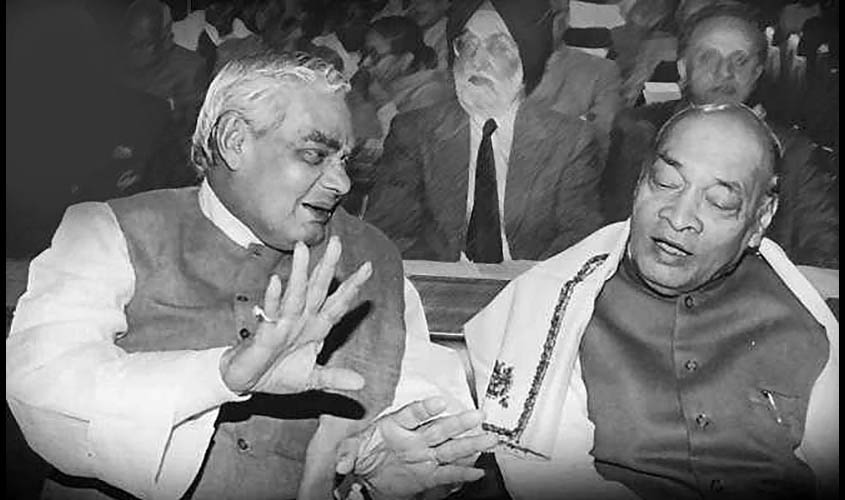Two Buddhas smiled
One of Atal Bihari Vajpayee’s closest friends was P.V. Narasimha Rao. The two gentlemen shared many secrets and quietly worked together to strategise many plans in national interest. This writer is privy to some of the great things that Rao and Vajpayee did together. One issue relates to the nuclear tests that Prime Minister Vajpayee conducted in May 1998, the tests that Prime Minister Rao had planned but could not conduct four years earlier. India’s first nuclear te st, called Smiling Buddha, was conducted by Prime Minister Indira Gandhi in 1974. Vajpayee’s tests, five in number, came in May 1998. This columnist heard about how the tests were conducted first from Vajpayee himself, and later from Narasimha Rao. “If Narasimha Raoji had not guided me on how to go about these nuclear tests, I might not have succeeded,” Vajpayee said. During Rao’s regime, the nuclear tests were put on hold because of American pressure. The Bill Clinton administration conveyed its concern to India after preparations were detected by American satellites. One day, the US ambassador in New Delhi sought an urgent appointment with Rao and met him at the Prime Minister’s Office in South Block. When the envoy expressed America’s concern about India’s imminent nuclear explosions, Rao pleaded ignorance. The ambassador was confused but said, “We have proof, our satellites have taken pictures of secret preparations in Pokhran. India is just a few days away from these explosions. Please stop.” The ambassador then placed the satellite pictures on the PM’s table. Rao looked at the pictures for long and with a poker face said, “Strange.” Then he asked the ambassador whether he could leave these pictures with him for an hour “so that I can confront my people”. The ambassador agreed, thinking his mission to stop the tests had succeeded.
The moment he walked out of the room, an angry Rao summoned India’s top nuclear scientists, including A.P.J. Abdul Kalam, the Scientific Advisor to the Defence Minister, and trusted Army and intelligence officers. But before that he got photocopies of the satellite pictures made. Rao then showed the satellite pictures to them and asked: “How did the Americans come to know about our secret nuclear tests programme? I had told you to keep it under wraps.” He then asked them to wind up Pokhran and plan the tests for future. “You know American eyes are watching us from the sky,” he said. “Work on blocking those eyes.” Rao could not fulfil his dream during his Prime Ministership. Four years later, he encouraged PM Vajpayee to go for the nuclear tests. When the nuclear tests were carried out, the Americans were taken by total surprise. Dr A.P.J. Abdul Kalam (who later became President of India), as the Chief of Defence Research and Development Organization, supervised the Pokhran-II explosions, camping in the Thar desert for over a fortnight. US President Bill Clinton called the tests “unjustified” and slapped economic sanctions on India. But that did not matter any longer. Clinton and his satellites had failed to see how the “two Buddhas”, Rao and Vajpayee, were “smiling”.
‘Bol Radha Bol’
This writer met Atal Bihari Vajpayee many times during his lifetime. In the 1970s, as a cub reporter with the Statesman, I used to look forward to covering this Jana Sangh leader’s election rallies in the national capital. Huge crowds used to wait for hours at night to listen to the great poet and orator.
I had come to know Vajpayee through one of his dear friends, who worked as a journalist in Hindustan Samachar, a Hindi news agency run by senior RSS leaders. This journalist friend, who does not want to named, has many things to share about Vajpayee. Not many know that Vajpayee’s political career began with the Left’s Students Federation of India in Gwalior in 1942. The RSS pracharak Narayanrao Tarte later influenced Vajpayee to join the saffron parivar. Tarte, who knew 12 regional languages, taught Vajpayee in a Gwalior school in 1938. Much later, Tarte, who was popularly known as “Mammu”, inducted Vajpayee into the RSS. In 1951, Vajpayee became the founder-member of the erstwhile Jana Sangh and in 1957 was elected to the Lok Sabha for the first time. He was allotted an MP flat, number 110, on South Avenue. Later, he shifted to 1, Ferozshah Road as MP. In the initial years, from Teen Murti, near his South Avenue residence, he would take the DTC bus number 15A to go to Maurice Nagar near Delhi University’s north campus to meet a lady friend, whom he knew from his Gwalior days. She died some years ago. Vajpayee adopted her daughter, Namita, during his best friend’s lifetime. Vajpayee loved good food. His favourite dishes were aloo-puri, kachori, seekh kebab and meat. He was a good cook. He loved to make khichri with vegetables. Sweets were his weaknesses. As a youth leader, and even as PM, his standing instruction to close friends was to get him the famous sweets from wherever they were visiting him. A BJP minister from Delhi regularly brought him Chandni Chowk’s jalebi.
A little known secret is that Vajpayee in his youth, and later too as MP, used to take bhang. When our common journalist friend once asked him why he took bhang, Vajpayee replied, “My dear, it opens your brain’s windows.”
A young Vajpayee also used to watch romantic Hindi films, mostly at the instance of close friend L.K. Advani. My journalist friend recalls the day when he, Vajpayee and Advani went to see Sangam at Regal cinema in Connaught Place in 1964. For long, Vajpayee would sing the song’s first line, “Bol Radha bol sangam hoga ki nahin”.

